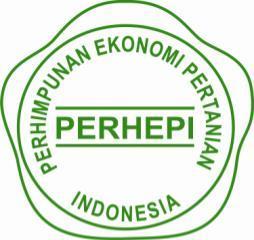Pemanfaatan Berbagai Jenis Gulma sebagai Bahan Biosaka untuk Meningkatkan Produksi Bawang Merah (Allium ascolanicum L.)
Utilization of Various Weeds as Biosaka Materials to Increase the Production of Shallots (Allium ascolanicum L.)
DOI:
https://doi.org/10.51852/jaa.v7i2.681Keywords:
elicitor, formulation, shallot, weedsAbstract
Sustainable agricultural policies encourage agricultural innovations such as the use of bio saccharides as elicitors in plants. Biosaka contains chemical compounds that trigger a positive response in plants. Shallots are a superior commodity whose cultivation practices often do not pay attention to the negative impacts on the environment. Using biosaka as an alternative can support more environmentally friendly shallot farming. This research aims to identify the effect of using a biosaka elicitor on the growth and production of shallots. The research was carried out from July to September in Kab. Subang, West Java with an altitude of 10 m above sea level. The biosaka elicitor treatment was carried out using 3 treatment formulas, namely A: formula 1 (babadotan, kitolod, anting-anting, maman lanang, and pasang bumi), B: formula 2 (jelantir, sembung, patikan kebo, meniran, and sembung rambat), C: formula 3 (babadotan, anting-anting, sembung, jelantir and meniran), D: control (without elicitor), treatment was repeated 6 times. The results of the research show that all weed-based bio saccharide elicitor formulations can increase plant height, number of leaves, and weight of onion bulbs. Selection of appropriate elicitors with appropriate cultivation techniques can produce optimization plant product.
References
Albrecht U. 2019. Plant Biostimulants: definition and overview of categories and effects. UF/IFAS Extension. 5 (3): 1–4. Available at: https://doi.org/10.32473/edis-hs1330-2019.
Azmi, Hidayat IM, Wiguna G. 2011. The effect of varieties and size of bulbs on shallot productivity. Jurnal Hortikultura. 21 (3): 206–213.
Bayraktar M, Naziri E, Karabey F, Akgun IH. 2018. Enhancement of stevioside production by using biotechnological approach in in vitro culture of Stevia rebaudiana. International Journal of Secondary Metabolite. 5 (4): 362–374. Available at: https://doi.org/10.21448/ijsm.496724.
Dhiaswari DR, Santoso AB, Banowati E. 2019. Pengaruh perilaku petani bawang merah dan penggunaan pestisida terhadap dampak bagi lingkungan hidup di Desa Klampok Kecamatan Wanasari Kabupaten Brebes’, Edu Geography. 7 (3): 203–211.
du Jardin P. 2015. Plant biostimulants: Definition, concept, main categories and regulation. Scientia Horticulturae. 196: 3–14. Available at: https://doi.org/10.1016/j.scienta.2015.09.021.
Kanthaliya B, Joshi A, Arora J, Alqahtani MD, Abd_Allah EF. 2023. Effect of biotic elicitors on the growth, antioxidant activity and metabolites accumulation in in vitro propagated shoots of Pueraria tuberosa. Plants. 12 (6): 1–16. Available at: https://doi.org/10.3390/plants12061300.
Lee R, Baldwin S, Kenel F, McCallum J, Macknight R. 2013. Flowering locus T genes control onion bulb formation and flowering. Nature Communications. 4(July 2015): 2884. Available at: https://doi.org/10.1038/ncomms3884.
Major N, Ban SG, Urlic B, Ban D, Dumicic G, Perkovic J. 2018. Morphological and biochemical diversity of shallot landraces preserved along the Croatian coast. Frontiers in Plant Science. 9(December). hlm 1–14. Available at: https://doi.org/10.3389/fpls.2018.01749.
Merillon JM, Ramawat KG. 2012. Plant defence: Biological control, Plant Defence: Biological Control. Available at: https://doi.org/10.1007/978-94-007-1933-0.
Namdeo AG. 2007. Plant cell elicitation for production of secondary metabolites : A review. Review Literature And Arts Of The Americas. 1 (1): 69–79. Available at: http://www.phcogrev.com/article.asp?issn=0973-7847;year=2007;volume=1;issue=1;spage=69;epage=79;aulast=Namdeo;type=0.
Quang HT, Thi PTD, Sang DN, Tram TTN, Huy ND, Dung TQ, The QTT. 2022. Effects of plant elicitors on growth and gypenosides biosynthesis in cell culture of Giao co lam (Gynostemma pentaphyllum). Molecules. 27(May), hlm 1–10. Available at: https://doi.org/https://doi.org/10.3390/molecules27092972.
Reflis R, Sumartono E. 2023. Biosaka Pengembangan Pertanian Organik. Community Development Journal. 4(2): 2939–2945. Available at: http://journal.universitaspahlawan.ac.id/index.php/cdj/article/view/14691%0Ahttp://journal.universitaspahlawan.ac.id/index.php/cdj/article/download/14691/11564.
Simanjuntak A, Lahay RR, Purba E. 2013. Respon pertumbuhan dan produksi bawang merah (Allium ascalonicum L.) terhadap pemberian pupuk npk dan kompos kulit buah kopi. Jurnal Online Agroekoteknologi. 1(3): 362–373.
Sumarni N, Rosliani R, Basuki RS. 2016. Respons pertumbuhan, hasil umbi, dan serapan hara npk tanaman bawang merah terhadap berbagai dosis pemupukan npk pada Tanah Alluvial’, Jurnal Hortikultura. 22(4): 366–375. Available at: https://doi.org/10.21082/jhort.v22n4.2012.p366-375.
Twaij BM, Hasan MN. 2022. Bioactive secondary metabolites from plant sources: types, synthesis, and their therapeutic uses. International Journal of Plant Biology. 13 (1): 4–14. Available at: https://doi.org/10.3390/ijpb13010003.
Ulfa F, Syam’un E, Rafiuddin. 2018. Teknologi budidaya bawang merah ramah lingkungan. Jurnal Dinamika Pengabdian (JDP). 4 (1): 32–41. Available at: http://journal.unhas.ac.id/index.php/jdp/article/view/5279.
Wagiman M. bin, Hadi P, Rahayu T. 2021. Peningkatan pertumbuhan dan hasil bawang merah dengan aplikasi perbedaan konsentrasi bio slurry dan pemotongan umbi bibit. Agroplantae: Jurnal Ilmiah Terapan Budidaya dan Pengelolaan Tanaman Pertanian dan Perkebunan. 10 (1): 40–49. Available at: https://doi.org/10.51978/agro.v10i1.251.


1.png)









